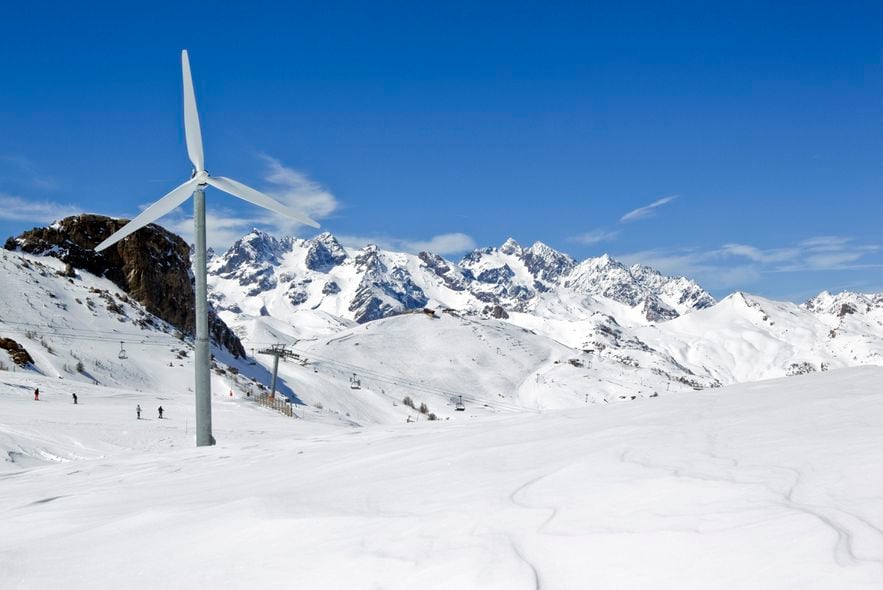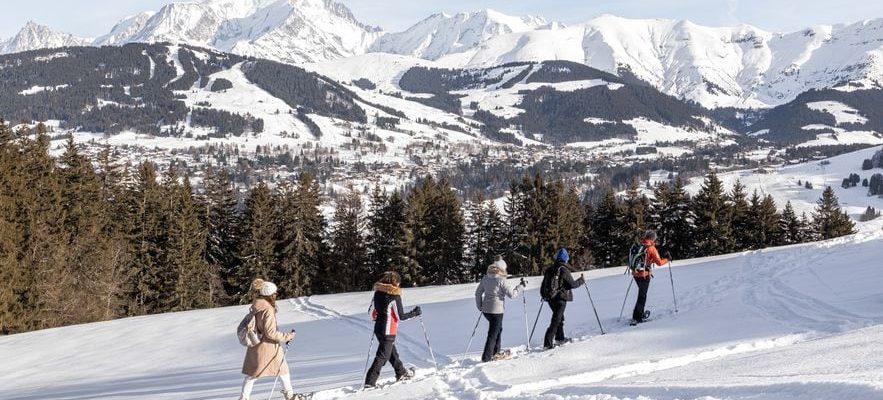The mountain is bearing the brunt of the effects of global warming with a very bleak future since in thirty years, all the small glaciers will have disappeared. An irreversible phenomenon that takes place over time: since 1970, France has lost five weeks of snow at an altitude of 2,100 meters. And since 1952, the forest limit has climbed 60 meters (according to CREA Mont-Blanc). There is therefore no alternative and to last, the resorts seek to reduce their consumption of fossil energy, to promote ecological activities and to act for the rehabilitation of natural areas. A vast movement which results in countless initiatives, discreet or large-scale.
Reduce road trips
The urgency is decarbonization. The main source of pollution in the mountains remains travel to the resorts, which represents 52% of greenhouse gas emissions from a winter sports holiday, according to the Environment and Management Agency. energy (Ademe). To limit car use, proximity to an SNCF station is therefore a valuable asset. Because the train remains the cleanest mode of transport, emitting up to 30 times less CO2 per passenger. Let us salute here the (modest) rebirth of the night train between Paris and the Hautes-Alpes, the Pyrénées-Orientales, Ariège…
We still need clean shuttles for the last journey. They are rare. Among the champions of car-free access, the Arc 1 600 station (Savoie) stands out hands down thanks to its free funicular for anyone with an SNCF ticket which connects it directly to Bourg-Saint-Maurice TGV. The same goes for Le Lioran, in Cantal, where the rail stops at the foot of the slopes.
If geography and budgets allow it, municipalities adopt the radical solution of the valley elevator – a cable car – to connect the valley and the resort: Crémaillère Express from Luchon to Superbagnères, Skyvall from Loudenvielle to Peyragudes, Baou d’Ax- les-Thermes in Bonascre, Eau d’Olle Express d’Allemond in Oz 3300, etc. Note, among the projects, the one which would make it possible, with a view to the 2030 Winter Olympics, to reach the Sybelles area from Saint-Jean-de-Maurienne for a budget of 50 million euros.
Snow groomers without fossil fuels
Once on site, and on the operational side, snow groomers represent the stations’ main source of CO2 emissions. Thus, several studies are underway to replace their fossil fuel propulsion method with hydrogen: in Alpe-d’Huez, five partially modified machines were to be tested this winter. Manufacturers are also working on electric models but their cost currently remains too high. In the meantime, the groomers can be hybrids (Peyragudes), feed on GTL (Gas to liquids), a synthetic diesel without fine particles or sulfur dioxide, or even be powered by biofuel or HVO made from filtered fats and frying oils. A mixture chosen by the Les Arcs station which announces, for its tracked vehicles, reductions of 83% in CO2 and 65% in fine particles.
At the same time, the management of trails, grooming routes, water resources and overall maintenance of the area has become “intelligent” thanks to the Snowsat on-board GPS which helps to optimize resources as best as possible. In Les Menuires and throughout the Belleville valley (Savoie), a fuel saving of around 8% and up to 15% for the production of artificial snow is estimated. The latter is even stopped earlier in the season, like what is done in Queyras from January 15! Finally, most resorts have definitely adopted common sense measures: eco-driving of snow groomers, slowing down of the motors of ski lifts, cable cars, chairlifts or other gondolas in the event of less traffic on the slopes, even closing duplicate installations, etc.
Improve accommodations
Reducing the number of ski lifts also contributes to this responsible movement. “Across the entire territory, they increased from 3,700 in 2010 to 3,089 in 2022 [-16,5 %]without reducing the number of slopes”, assures Alexandre Maulin, president of Domaines skiables de France. Fewer devices, dismantling of dying installations (71 recorded to date by DSF), fewer pylons , less footprint on the landscape, less energy consumed and yet more skier flow. Some examples: the Crémaillère Express de Luchon went from 28 to 15 pylons. The old Jandri des Deux-Alpes is soon aiming for more than 7 (instead of 17) while hoping for a precious gain in climb time (17 minutes instead of 40).
Finally, a major challenge of the immediate future, thermal sieve accommodation: according to a recent study by the Heero firm, specialized in energy renovation, 1 in 2 accommodations would be classified F or G (therefore soon prohibited for rental). Incentive policies for owners exist in Cauterets with its Green Diamond label, in Sybelles with financial aid, in Orcières since 2014 and even in Tignes. “Our goal is to achieve carbon neutrality in 2037 for our operating activities,” promises Jean-Yves Remy, CEO. of Labellemontagne (9 areas under management). While in Orres, we are aiming for the same horizon in 2050, all mobility included. The slope towards zero carbon is still steep.
Initiatives for greener skiing
• Calculate your carbon footprint on futurclimatique.org
Examples: 1 skier day = 48.9 kilos of CO2, including 52% transport, 16% equipment (skis, jacket, etc.), 4% accommodation and 3% ski area facilities (UTOPIES study on Tignes, La Clusaz and Le Grand- Bornand). Paris – Tarentaise R/T by TGV, approximately 10 hours = 2.2 kilos of CO2 per person; by thermal car, approximately 2:40 p.m. = 160 kilos of CO2 per car.
• Better travel in Isère on itinisere.fr
• Pierre & Vacances signed a partnership with TicTacTrip and developed its “Sunday” offers. The group has banned plastic film to protect laundry (3,000 kilometers/year!) and will have 100% of its residences labeled Green Key in 2025.
• The Evian shuttle to the resorts in the Evian region: €1. From Nice station to the Alpes-Maritimes resorts (Auron, Isola, etc.): 100% snow bus, €14 return with 1 piece of luggage and skis (lignedazur.com).
• The online travel agency La Plagne Resort has removed air travel solutions from its packages.
• A version without airplane option is offered on GoSavoieMontBlanc.com
• In Valberg (level 2 of the Flocon Vert label), the intramural shuttles are electric.
• In Queyras, 28 eco-responsible accommodations are offered under the “Valeur Parc” brand of the Regional Natural Park.
• In Menuires (Savoie), an employee nicknamed Monsieur Vélo was hired to manage a large soft mobility budget.
• Bank loans intended to invest in ski areas, ski lifts in particular, are now linked to the existence of a real environmental policy on the part of the operators.
• The organization of an event in a resort is subject to a declaration imposed on the organizers by the Prefecture, the Region or the department (depending on the funding obtained), justifying the existence of a policy of public awareness of environmental problems and restoration of the premises.
• For their goodies – these small gifts most often made in Asia – the resorts are required to seek the lowest possible carbon impact. It is difficult, however, to know precisely where they come from, even when using a local intermediary. In La Plagne, Courchevel or Les Arcs, goodies are now guaranteed to be made in Europe.
Megève is engaged in a collective reflection project. With the objective of maintaining all its activities (here a snowshoe hike).
© / SDP
• Megève is engaged in a collective reflection project, with 100 defined actions and 32 operational objectives for 2038. Example: the Saulire Express solar power plant (400 square meters) in 2022.
• In the village of Cordon, facing Mont Blanc, the 100% LED public lighting is turned off between 12 a.m. and 5 a.m.
• The connected Sybelles area, in Maurienne, has decided to stop night skiing.
• Not trivial: in Pralognan-la-Vanoise, the goats recycle the forty Christmas trees used by the municipality, which are taken according to their condition from selected areas, freeing up space for raising pigs woolly in summer, which will also be nourished by the whey coming from the goats which have ingested the fir trees.
Housing renovation
HAS Montgenèvre (Hautes-Alpes), where 40% of residences date from after 2010, we also follow a QSE policy for buildings in the ski area. Tignesit offers a partnership with owners to raise awareness of the energy renovation of accommodation, with bonuses (reduction on packages for example) in the event of rental. Maeva Home suggests to owners a support program for the renovation of their apartments. The project is being carried out with Face/B, a turnkey solution, with a target of 500 housing units by 2025.
Drones to decarbonize
In Orres (Hautes-Alpes), the Center of Drone Excellence in the mountains (Patrolair company) is dedicated to piloting with theoretical and practical training. Its applications extend to mountain rescue (via installed thermal cameras), technical maintenance, damage management and monitoring of snow guns, avalanche risk prevention, etc. Such use of drones allows a visual assessment and therefore a reduction in travel by thermal vehicles (snow groomers, scooters, helicopters).

Since 2006, the Hautes-Alpes resort has implemented an ambitious environmental strategy. Here, wind turbines represent clean energy.
© / SDP
Serre Chevalier, peak station
Since 2006, the Hautes-Alpes resort has implemented an ambitious environmental strategy. Results :
– 30% of electrical energy needs produced on site, notably thanks to two hydroelectric power stations.
– 100% of snow groomers powered by HVO vegetable fuel, i.e. half of the fleet with 90% fewer CO2 emissions over a life cycle.
– 80% less GHG emissions linked to the operation of the station.
– 100,000 m3 less artificial snow between 2021 and 2022.
– Zero pollution peak in 2022.
Eco-commitments
1. Domaines skiables de France has established 16 eco-commitments for the use of its 396 members for carbon neutrality in 2037. For its part, the Business Convention for the Climate (80 members including the ESF, Fusalp, Chamrousse, the Trois Vallées…) works on the transition of territories via multi-activities. While Lama Project, a think tank on the future of mountains and resorts, has a mission to “enlighten and influence decision-makers and users […] to encourage the transition to new economic models.
2. The 16 eco-commitments established by Domaines Skiables de France for the use of its 396 members support a carbon neutrality objective in 2037, a movement shared by almost the entire French mountain region. Among the global initiatives, that of Lama Project, a think tank on the future of mountains and resorts, is intended to “enlighten and influence decision-makers and users of ski resorts to encourage the transition towards new economic models responding to future challenges”. Or that of the CEC, Business Convention for the Climate, which brings together 80 companies and institutions (including the ESF, Fusalp, Chartreuse, the Chamrousse resort, the Trois Vallées company, etc.) which are rethinking their economic model according to a sheet of road, particularly via non-energy-intensive activities.
3. In Tignes, we are adapting marketing with a “sustainable occupancy indicator”, a statistical evaluation of the presence of vacationers based on their geographic origin. “We are not looking for overcrowding, but for reasonableness,” says Frédéric Porte, general manager of the station. The idea being to redirect marketing towards local countries, neglected in recent years in favor of distant destinations.
.
